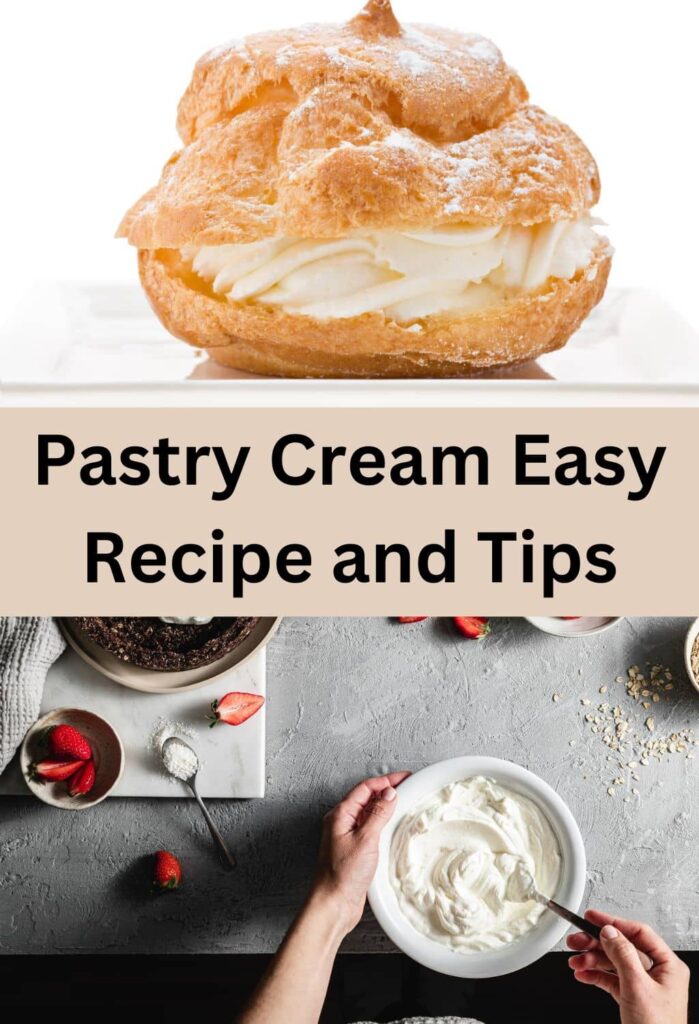What is Pastry cream? Pastry cream is an essential ingredient for bakers who love to bake different types of pastry and other baked recipes.
Pastry cream is made with milk, egg yolk, sugar, cornstarch, and vanilla and is often used for flavoring. Heat all the ingredients on the stove until it’s thick but there is more to it.
It demands proper care and technique to make a good pastry cream. We have shared all the details, techniques, tips, and tricks with you and some easy recipes that you can make with pastry cream.
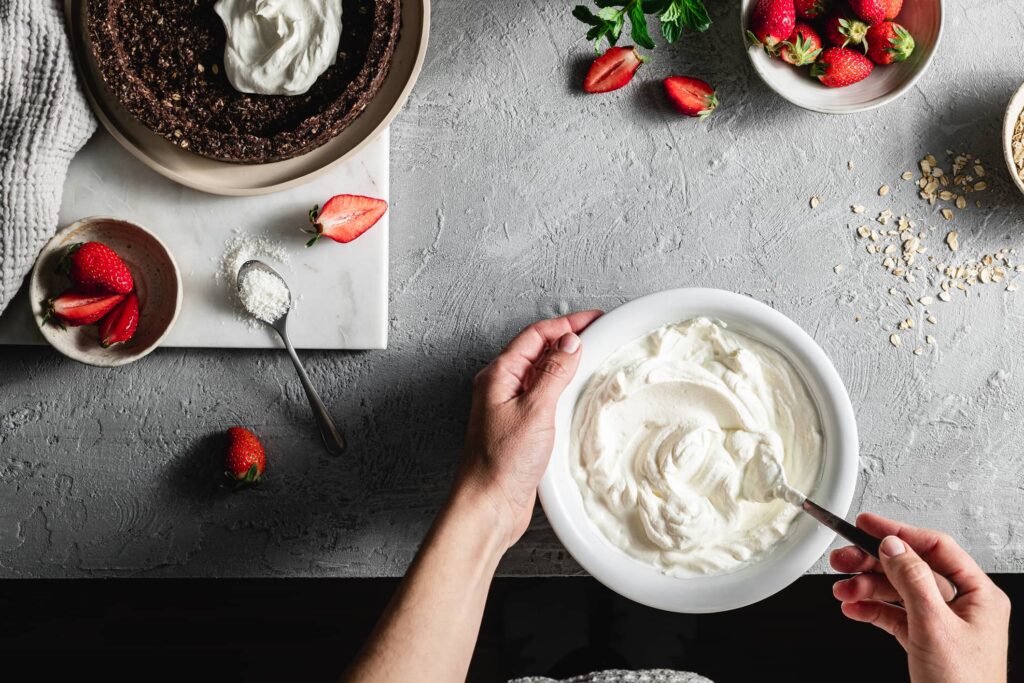
What is Pastry Cream
Pastry cream is also known as crème pâtissière. It is a custard-like cream made with milk, egg yolk, sugar, and cornstarch, cook until thick and creamy when it holds the shape.
The world of custard is very wide there are pouring custard-like crème anglaise that go on desserts or fruits. Then there are baked custards like flan and Crème Brûlée also thickened with eggs but more solid.
Finally, there’s pastry cream, a thick custard using both eggs and starch, making it great for piping or spreading and keeping its shape.
These ingredients are cooked together to create a custard which is usually thicker and stable enough to hold its shape when used as a filling. It’s a creamy, velvety custard that is often used as a filling for pastries, cakes, and tarts.
Whether you’re using it to fill éclairs, layer a cake, or top off a fruit tart, pastry cream is that secret ingredient that turns a good dessert into a showstopper.
What is Pastry Cream Made of
The basic ingredients are milk, sugar, egg yolk, starch, and vanilla for flavoring. Pastry cream is very easy to make when you follow the proper technique. If it isn’t made properly the texture may remain runny or blend. Each ingredient plays an important role in making a perfect pastry cream.
Milk
Milk serves as the base liquid for pastry cream. It provides moisture and contributes to the overall texture of the custard. The fat content in milk adds richness, while the proteins help set the custard during cooking.
Egg Yolks
Egg yolks act as a thickening agent and provide richness and a smooth, creamy texture to the pastry cream. They contain lecithin, a natural emulsifier that helps bind the ingredients together.
Sugar
Sugar sweetens the pastry cream, balancing the flavors and enhancing the overall taste. It also plays a role in stabilizing the custard, contributing to its texture and preventing it from becoming too dense.
Cornstarch or Flour
These starches are used as additional thickeners. Cornstarch is commonly preferred in pastry cream recipes because it creates a smoother texture. Flour can be used as an alternative, but it may result in a slightly different mouthfeel.
Vanilla Extract or Vanilla Bean
Importance: Vanilla adds flavor and aroma to the pastry cream. Whether using vanilla extract or vanilla bean, it imparts a warm, sweet, and aromatic quality that enhances the overall taste of the custard.
Butter
Butter adds a luxurious richness to the pastry cream, making it even creamier and more flavorful. While it’s optional, many pastry chefs choose to incorporate butter for a more indulgent texture.
Salt
A small amount of salt is often added to balance the sweetness and enhance the overall flavor profile of the pastry cream. It helps to round out the taste and prevent the custard from being overly sweet.
What is Patry Cream Used For
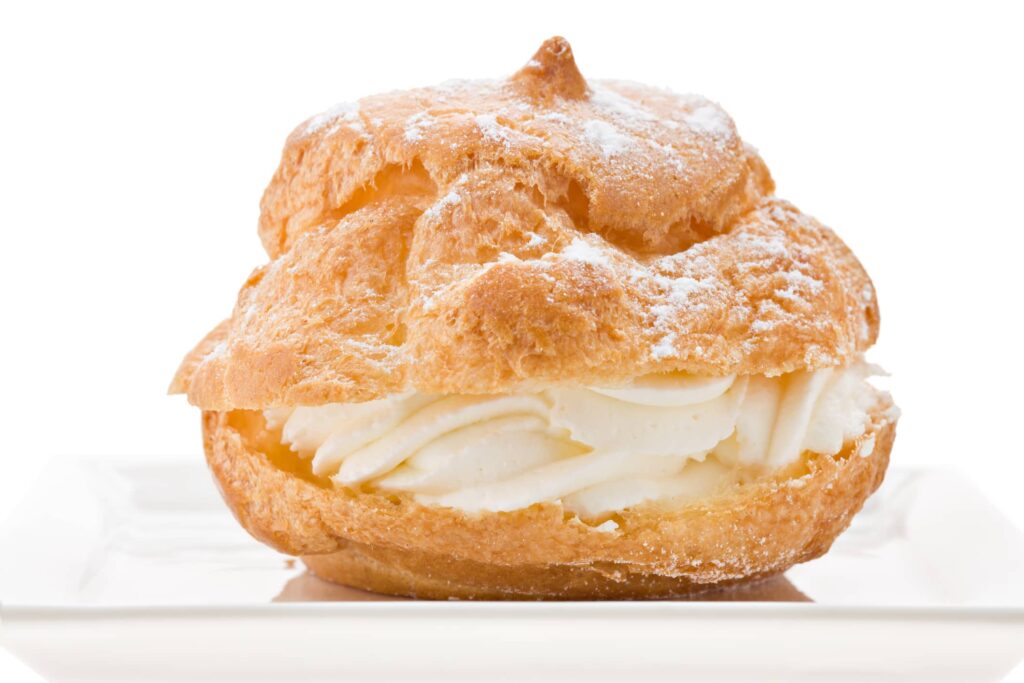
It is a rich and creamy custard-like filling that adds a delightful flavor and texture to a variety of baked desserts.
Éclairs: Pastry cream is often piped into éclairs, a type of pastry, to create a creamy filling.
Cream Puffs: Similar to éclairs, cream puffs are filled with pastry cream, creating a delicious contrast to the light and airy pastry shell.
Torte Filling: Pastry cream can be used as a filling between layers of sponge cake or other types of cakes. It adds a luscious and creamy element to the dessert.
Fruit Tart Filling: Pastry cream serves as a base layer in fruit tarts. It provides a smooth and sweet foundation for the arrangement of fresh fruits.
Danish Pastries: Pastry cream can be incorporated into Danish pastries, along with fruit or nuts, for a delicious breakfast or dessert treat.
Turnovers: Similarly, turnovers can be filled with pastry cream for a sweet and satisfying flavor.
Layers in Mille-Feuille: Pastry cream is a key component in mille-feuille, also known as Napoleon pastry, where layers of puff pastry are alternated with layers of pastry cream.
Boston Cream Pie: This classic dessert features layers of sponge cake, pastry cream, and chocolate ganache.
Doughnut Filling: Pastry cream can be used as a filling for doughnuts, either injected into the center or spread on top.
Layered Desserts: You can fill pastry cream layered with fruits, cake, or cookies in trifles or parfaits for a decadent and visually appealing dessert.
Crepe Filling: Pastry cream can be used as a filling for crepes, either alone or combined with fruits.
Cannoli: Pastry cream can be used as a filling for cannoli, an Italian pastry tube filled with a sweet and creamy mixture.
Types of Pastry Cream
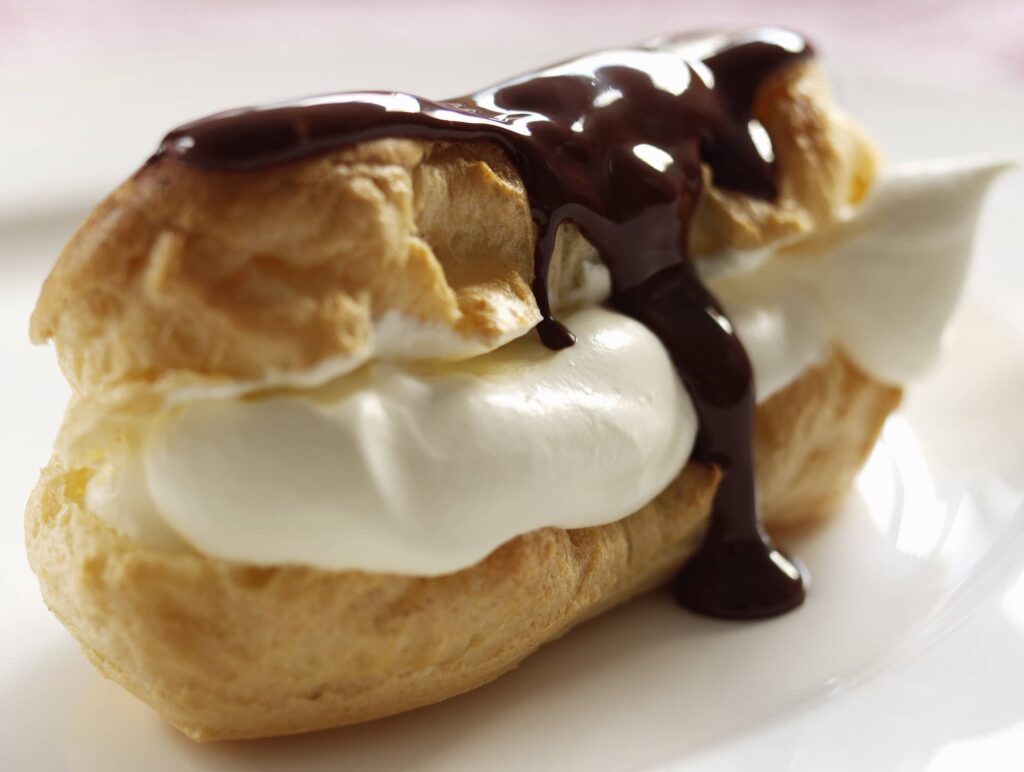
Pastry cream is a versatile and delicious custard-like filling used in various pastries and comes in different flavors to suit diverse tastes.
The classic vanilla pastry cream is a smooth blend of milk, sugar, egg yolks, and vanilla extract, offering a timeless and comforting taste.
Chocolate pastry cream adds a rich and indulgent twist, combining cocoa with the base ingredients for a delightful chocolatey experience.
For those seeking a fruity flair, fruit-flavored pastry creams like lemon or raspberry infuse freshness into the creamy base.
Pastry Cream Recipe
To prepare perfect pastry cream start by gathering the following ingredients:
2 cups of whole milk, 1 vanilla bean (or 1 teaspoon of vanilla extract), 6 large egg yolks, 1 cup of granulated sugar, 1/2 cup of all-purpose flour, and a pinch of salt.
Begin by splitting the vanilla bean lengthwise and scraping out the seeds. In a saucepan, combine the milk, vanilla bean, and seeds. Heat the mixture over medium heat until it simmers, then remove it from the heat and let it steep for about 15 minutes.
In a separate bowl, whisk together the egg yolks, sugar, flour, and salt until the mixture becomes pale and slightly thick. Remove the vanilla bean from the milk and slowly pour the warm milk into the egg mixture.
Once combined, return the mixture to the saucepan and cook over medium heat. stir constantly with a wooden spoon or heat-resistant spatula. The pastry cream will thicken, and it’s crucial to continue stirring to prevent lumps.
Tips for making perfect pastry cream
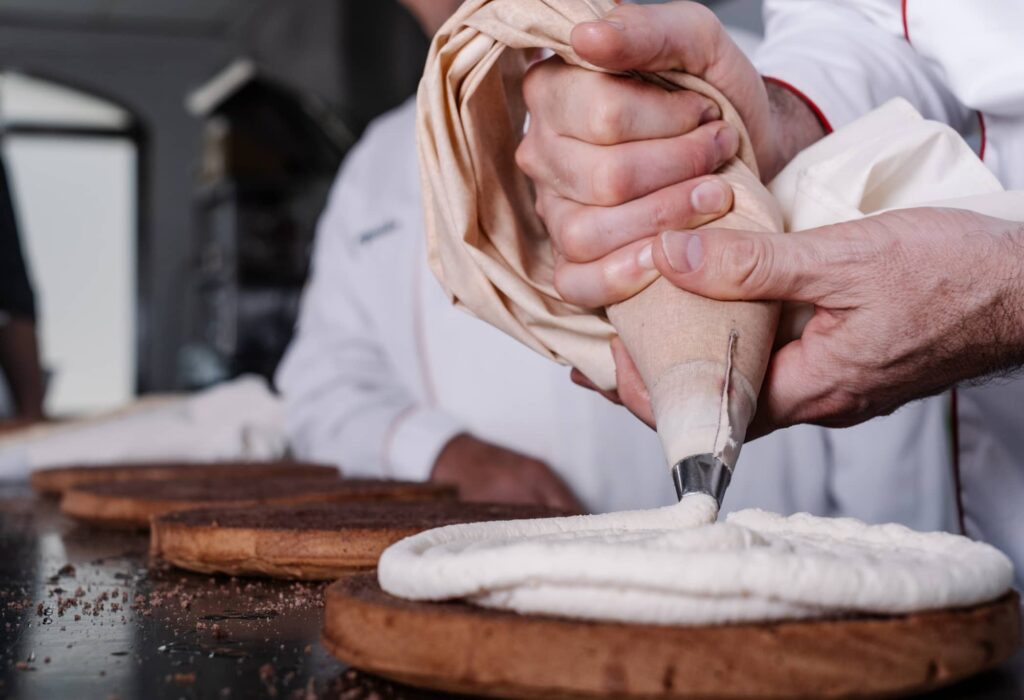
You can make perfect pastry cream when you use the proper tips.
- When the cream reaches a custard-like consistency, remove it from the heat and strain it through a fine-mesh sieve to ensure a smooth texture.
- When adding eggs into the hot milk mixture, temper them first by gradually adding a small amount of the hot liquid while constantly whisking. This prevents the eggs from scrambling.
- Strain the pastry cream through a fine-mesh sieve after cooking to remove any potential bits of cooked egg or lumps. This step ensures a smooth texture.
- Whisk the pastry cream continuously during cooking. pay more attention to the corners of the saucepan to avoid any sticking or burning. This helps in achieving a smooth consistency.
- Combine the cornstarch and sugar thoroughly before adding them to the egg mixture. This helps prevent clumps of cornstarch in the final pastry cream.
- Allow the pastry cream to thicken properly during cooking. It should coat the back of a spoon. when you draw a line with your finger, it should hold its shape.
How to Store Pastry Cream
- Allow the pastry cream to cool completely at room temperature.
- Cover the surface of the pastry cream with plastic wrap. Make sure the plastic wrap is directly touching the cream to prevent skin from forming.
- Place the covered bowl of pastry cream in the refrigerator. Keep it in the coldest part of the fridge.
- Consume the pastry cream within 2-3 days for the best quality. If it separates a bit after refrigeration, whisk it gently to restore its creamy consistency.
How to know if pastry cream is bad
If pastry cream has gone bad you can find it by smelling or touching it. To determine if pastry cream has gone bad, rely on your senses and observe changes in its appearance, smell, and texture.
If you find any signs of discoloration, mold, or an unusual separation of ingredients throw the pastry cream immediately. A fresh and properly made pastry cream should have a smooth consistency and a vibrant, uniform color.
Next, take note of its aroma; if the pastry cream emits a sour or off-putting smell, it is likely spoiled. Lastly, assess the texture by ensuring it remains creamy without any lumps or curdled aspects.
Always store pastry cream in the refrigerator and follow proper food safety guidelines to prolong its shelf life.
Frequently Asked Questions (FAQs)
Is pastry cream the same as custard?
Yes, Pastry cream is a type of custard. There is a variety of custard there are pouring custard-like crème anglaise that go on desserts or fruits. Then there is baked custard flan and a thick custard that holds the shape and is best for piping and spreading is pastry cream.
What is the difference between pastry cream and whipped cream?
Pastry cream and whipped cream both are used as toppings with different textures and flavors. Pastry cream is a rich and thick custard used for filling in puffs pastry, and eclairs. It is usually thickened with egg yolk.
On the other hand, Whipped cream is rich, light, and airy achieved by beating the heavy cream. It is soft, airy, and light.
Related Post: All About Namoura Middle Eastern Dessert
Ingredients
2 cups whole milk
1/2 cup granulated sugar
1/4 cup cornstarch
1/4 teaspoon salt
4 large egg yolks
2 tablespoons unsalted butter
2 teaspoons pure vanilla extract
INSTRUCTION
- In a medium saucepan, heat the milk over medium heat until it is steaming but not boiling. Stir occasionally to prevent skin from forming.
- In a separate bowl, whisk together sugar, cornstarch, and salt.
- In a heatproof bowl, whisk the egg yolks. Gradually add the dry ingredient mixture, whisking constantly to avoid lumps.
- Once the milk is steaming, slowly pour it into the egg mixture while whisking continuously. This process, known as tempering, ensures that the eggs gradually come to the temperature of the hot milk without curdling.
- Pour the mixture back into the saucepan and place it over medium heat.
- Whisk constantly until the mixture thickens and comes to a boil. This usually takes about 5-7 minutes.
- Once it reaches a boil, continue to whisk for an additional 1-2 minutes to ensure the cornstarch is fully cooked.
- Remove the saucepan from heat and stir in the butter and vanilla extract until the butter is completely melted.
- For a smoother texture, you can strain the custard through a fine-mesh sieve into a clean bowl to remove any potential lumps.
- Place a piece of plastic wrap directly on the surface of the pastry cream to prevent skin from forming.
- Allow the pastry cream to cool to room temperature and then refrigerate for at least 2 hours or until chilled.
